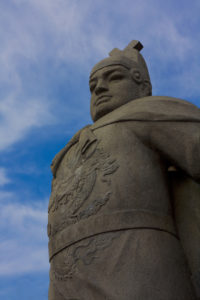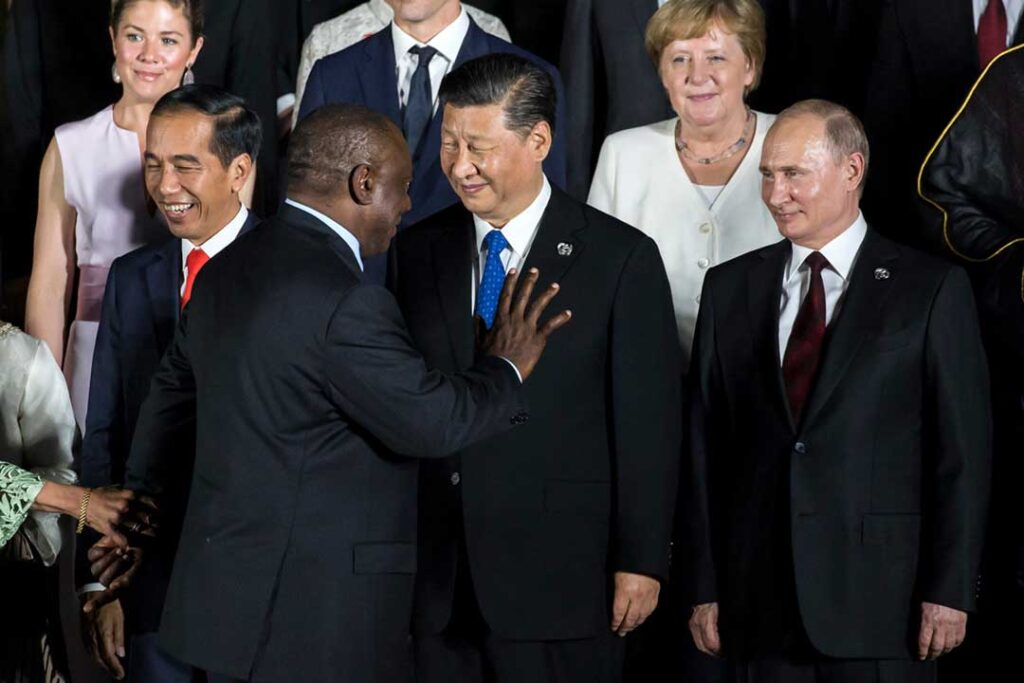China: the special relationship
Economic and political ties between Africa and China have led to infrastructural development on a monumental scale but their roots go back millennia

No one knows exactly how long ago the friendship between China and Africa began but contact and trade between the two can be traced as far back as 202 BC. This relationship deepened in the 14th century during the expedition of Ibn Battuta, a Moroccan scholar and explorer, to parts of Asia. The China-Africa connection was furthered in the same century by the travels of Sa’id of Mogadishu, a scholar who is said to have been the first African to study Mandarin. Besides being a pioneer in the translation of Mandarin to native African languages, Sa’id is credited with playing a role in establishing Somali merchants as leaders in the trade between Asia and Africa. In the 15th century, during the Ming Dynasty, Zheng He, a Chinese diplomat, admiral and explorer, is reputed to have made voyages to the Horn of Africa, passing Ajuran, a Somali empire that commanded the Indian Ocean trade.
Scholars now believe that during his final voyages Zheng followed the coast down to the Mozambique channel, between Madagascar and Mozambique. But while these medieval voyages might have established a strong foundation for relations between the two, it is China’s rapid economic growth in the late 20th and early 21st centuries, creating unprecedent demands for resources such as oil and other raw materials, that has undoubtedly underpinned the modern economic, political, and social ties between China and Africa. As Kenyatta University senior economics lecturer Emmanuel Manyasa notes, at no time has the friendship between China and Africa “been more pronounced” than in the 21st century. Kampala-based historian Peter Chemaswet argues that connections were first cemented in the late 1950s, when China signed the first bilateral trade pact with a number of African countries, namely Sudan, Guinea, Egypt, Morocco and Algeria.
More trade agreements were signed in late 1963, early 1964 with at least 10 recently independent African countries, when China’s first premier, Zhou Enlai, toured the continent. African signatories included Egypt, Algeria, Morocco, Tunisia, Ghana, Mali, Guinea, Sudan, Ethiopia and Somalia. The premier’s Ghana leg of his tour was regarded as a particular landmark because the country’s leader, President Kwame Nkrumah, was seen at the time as a champion of a united Africa. “The premier’s tour of Ghana was a strategic move that opened doors for China to warm its co-operation with African countries. It is in Ghana that the China- Africa relationship was actually born,” says Joel Savage, a Ghanaian journalist and author based in Brussels. Zhou’s prime objective in Africa was to elevate China’s profile on the continent, and in a speech in Mogadishu at the end of his trip the premier said China would support revolutionary struggles throughout Africa and fiercely oppose foreign interventions.
The outcome of Zhou’s visit was evident in 1971 when 26 African countries voted in the United Nations with 50 others to recognise the People’s Republic as the only legitimate China representative at the UN, replacing Taiwan, which had held the seat since 1949. The foundation of the current relationship between China and Africa was laid with the Beijing Declaration in October 2000 and the announcement of the Forum on China-Africa Cooperation (FOCAC) at a conference attended by at least 80 ministers from China and 44 other countries, as well as representatives from 17 international and regional organisations. Chinese President Jiang Zemin, Premier Zhu Rongji and Vice-President Hu Jintao were all present at the conference. “This is when the serious work that we see today between China and Africa began,” says Hongxiang Huang, the director of China House, a Nairobi-based research think tank he founded in 2014. Since then, China’s relationship with Africa has grown exponentially.
In 2006, at a FOCAC summit in Beijing attended by 35 African countries, the then president, Hu Jintao, rolled out $5 billion concessionary loans to Africa. The president also, as one of the “eight measures” for Sino-African relations, announced the creation of the China-Africa Development Fund to stimulate his country’s investment in Africa with $1 billion of initial funding. In 2009, the year China became Africa’s biggest trading partner, surpassing the US, a FOCAC ministerial conference in Egypt further defined China-Africa relations. At the conference an action plan to deepen cooperation was announced, including a $10 billion low-cost loan, double the amount committed in 2006. An additional $1 billion special loan for small- and medium-sized African enterprises was also established. At the same time, Premier Wen Jiabao announced a debt write-off for poor African nations, the construction of 100 new energy projects and a gradual lowering of custom duties on 95% of products from African countries with which China had diplomatic ties.
Crucially, China said it would ensure that Africa attained a stable food supply and it would provide the continent with modern medical equipment to fight malaria. Trade between China and Africa has expanded at an average annual rate of 20%, from $13 billion in 2001 to $188 billion in 2015. Figures from China’s General Administration of Customs show that in 2018, the country’s total import and export volume with Africa was $204.19 billion. During that period, China’s exports to Africa were $104.91 billion, up by 10.8%, and China’s imports from Africa were $99.28 billion, translating to a 30.8% increase. However, some analysts and observers – and the International Monetary Fund (IMF) – have cautioned that China’s economic slowdown and the sharp drop in commodity prices presents a risk for resource-dependent sub-Saharan African countries. The IMF, for example, has advised countries to look at diversifying their economies and reducing their reliance on natural resource exports.
On the other hand, China’s demand for consumer-related resources such as agricultural raw materials and food products has increased, and this focus on agriculture is likely to intensify China- Africa trade. To date, China has acquired 252,901 hectares of land for agriculture in Africa. According to the China Africa Research Initiative, a research programme dedicated to understanding the political and economic aspects of China-Africa relations, at the Johns Hopkins University School of Advanced International Studies, China has also established 14 agricultural centres across Africa, “taking an increasingly hands-on role in its work and investment related to African agriculture, leasing and developing land”. China is also synonymous with large scale infrastructural investment in Africa, historically epitomised by the construction of the 1,710 km Tanzania-Zambia railway, which was completed in 1976. “China finances one in five projects; it also engages in the construction of one in three mega projects,” observes Luke Mulunda, a finance journalist who runs business today. co.ke in Kenya.
Transport, shipping, ports, energy, power, real estate – encompassing industrial, commercial and residential real estate – are some of the key infrastructural works in which China has invested in Africa. A Deloitte report by Hannah Edinger and Jean-Pierre Labuschagne published in March this year noted that to date China has participated in over 200 infrastructure projects in Africa. They said Chinese enterprises have completed and are building projects that “are designed to help add to or upgrade about 30,000 km of highways, 2,000 km of railways, 85 million tonnes per year of port throughput capacity, more than nine million tonnes per day of clean water treatment capacity, some 20,000 MW of power generation capacity, and more than 30,000 km of transmission and transformation lines”. The China-Africa friendship has also seen an expansion in aid. Currently, China is one of the largest country donors to Africa. However, critics argue that some support has been extended to Africa disguised as aid when in reality it is in the form of loans.
Analysts also point out that some African countries, happy to take advantage of China’s “ready-to-assist” policy – and willing to overlook questionable labour and environmental practices by Chinese business operations in Africa – have ended up choking themselves with loans. “The secrecy that shrouds Chinese operations, and corruption in many African countries, is what has perpetuated this time-after-time interchangeable use of aid and debt,” says Manyasa. According to The Brookings Institution, a non-profit public policy organisation based in Washington DC, China’s loan issuance to Africa has tripled since 2012. New debt issuance by Chinese institutions to African countries has gone up substantially in the past five years, rising to some $5 billion to $6 billion of new loan issuances each year in the 2013–15 period. McKinsey & Company say that in 2015, these loans accounted for about a third of new sub-Saharan African government debt. Most of the loans have been linked to infrastructure projects, such as China EXIM Bank’s $3.6 billion loan to finance the Mombasa-Nairobi Standard Gauge Railway in Kenya.
Ongoing Chinese investment in African infrastructure is in line with its Belt and Road initiative (BRI) announced by President Xi Jinping in 2013. This hugely ambitious transcontinental project aims to revive the ancient Silk Road for the 21st century, improving interconnectivity between Asia, Europe and Africa to increase trade and development along economic corridors – and enhance Chinese influence along the way. Unsurprisingly, therefore, that when China announced a new $60 billion African development fund at FOCAC 2018 in Beijing it was made clear the money would be channelled to projects, including ports, telecommunications, bridges and roads, aligned to the BRI. The John Hopkins China Africa Initiative says in a recent report that “from 2000 to 2017, the Chinese government, banks and contractors extended $143 billion in loans to African countries and their state-owned enterprises (SOEs).
Importantly, the report notes, however, that while some government loans qualify as “official development aid”, others are “export credits, supplier credits or commercial, not concessional in nature”. It is in this context that analysts caution that it is up to African governments to ensure that these funds are put to productive use to have the desired impact on their economies. Otherwise, as financial journalist Luke Mulunda says, African countries may find themselves in a serious debt trap, jeopardising their development.




